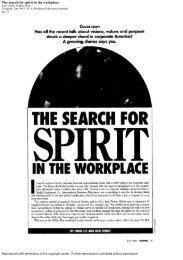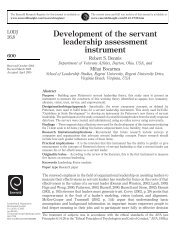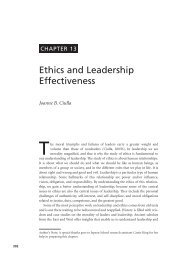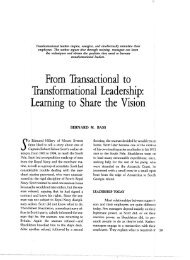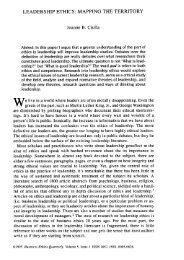Exploring a Taxonomy of Global Leadership ... - Strand Theory
Exploring a Taxonomy of Global Leadership ... - Strand Theory
Exploring a Taxonomy of Global Leadership ... - Strand Theory
You also want an ePaper? Increase the reach of your titles
YUMPU automatically turns print PDFs into web optimized ePapers that Google loves.
<strong>Exploring</strong> a <strong>Taxonomy</strong> <strong>of</strong> <strong>Global</strong> <strong>Leadership</strong> Competencies and<br />
Meta-competencies<br />
Stewart L. Tubbs, Ph.D. and Eric Schulz, Ph.D., Eastern Michigan University<br />
ABSTRACT<br />
There is a substantial body <strong>of</strong> research evidence regarding the importance <strong>of</strong> leadership development to<br />
organizational success, Charan, Drotter and Noel (2001), Fullmer and Goldsmith (2001), McCall and Hollenbeck<br />
(2002), McCauley, Moxley and Van Velsor (1998), Viceri and Fulmer (1997, Whetton and Cameron (2005). There<br />
is no more important task with regard to leadership development than identifying the competencies and metacompetencies<br />
that comprise leadership. However, to date, there has not been agreement regarding just what are the<br />
<strong>Global</strong> <strong>Leadership</strong> Competencies that should be taught and learned. In this paper leadership is defined as,<br />
“Influencing others to accomplish organizational goals,” (Tubbs, 2005). Based on the model presented in this paper,<br />
the rationale is advanced that some aspects <strong>of</strong> leadership are more or less fixed at a young age while others are able<br />
to be developed even well into adult life (i.e., the <strong>Global</strong> <strong>Leadership</strong> Competencies).<br />
This paper describes the model and identifies fifty <strong>Global</strong> <strong>Leadership</strong> Competencies in the form <strong>of</strong> a<br />
taxonomy <strong>of</strong> <strong>Global</strong> <strong>Leadership</strong> Competencies and Meta-competencies Most importantly, leadership development<br />
efforts must be targeted on the outermost circle in the model..<br />
INTRODUCTION<br />
Approximately $50 billion a year is spent on <strong>Leadership</strong> Development (Raelin (2004). Yet, two <strong>of</strong> the most<br />
frequently asked questions <strong>of</strong> leadership scholars is (1) what competencies and meta-competencies comprise<br />
leadership and (2) can leadership, in fact, be taught and learned. This paper attempts to answer both questions. Some<br />
aspects <strong>of</strong> leadership are more likely to be learnable and others are less so. For the purposes <strong>of</strong> this paper, leadership<br />
is defined as, “Influencing others to accomplish organizational goals,” Tubbs, (2005). <strong>Leadership</strong> is <strong>of</strong>ten discussed<br />
in terms <strong>of</strong> competencies, (Boyatsis (1982), Bueno and Tubbs, (2004), Chin, Gu and Tubbs (2001), Goleman,<br />
Boyatsis and McKee (2002), Whetton and Cameron, (2005). Competency is a term that describes the characteristics<br />
that lead to success on a job or at a task, Boyatsis (1982). Competencies can be described by the acronym KSA<br />
knowledge, skills and abilities. The model in Appendix A shows that leadership competencies can be represented by<br />
three concentric circles. These three circles describe three distinct aspects <strong>of</strong> leadership. The innermost circle<br />
includes an individual’s Core Personality. The second circle includes an individual’s values. The outermost circle<br />
represents an individual’s leadership behaviors and skills, (i.e., meta-competencies). The authors contend that (1) the<br />
attributes in the innermost circle are more or less fixed at a young age and are unlikely to be changed as a result <strong>of</strong><br />
leadership development efforts; (2) that a person’s values are somewhat more malleable than personality<br />
characteristics, yet more stable and perhaps more resistant to change than behaviors; and (3) that the behaviors<br />
represented in the outermost circle are the most likely to be changed through leadership development efforts. Each<br />
<strong>of</strong> these circles are be discussed below.<br />
PERSONALITY<br />
Personality represents the accumulation <strong>of</strong> enduring physical and mental attributes that provide an<br />
individual with his or her identity. These attributes result from the interaction <strong>of</strong> heredity and environmental factors.<br />
Determinates <strong>of</strong> personality can be grouped in four broad categories: hereditary, cultural, familial and social<br />
interactions. Each <strong>of</strong> these perspectives suggest that an individual’s personality is a relatively enduring<br />
characteristic formed early in their life. Genetic specialists argue that components <strong>of</strong> an individual’s personality are<br />
in large part heredity (Holden, 1988). Personality is also affected by an individual’s culture because it directs what<br />
an individual will learn and formats the context in which behavior is interpreted (H<strong>of</strong>stede, 1984). While the culture<br />
dictates and restricts what can be taught, a person’s family plays a key role in the constitution <strong>of</strong> an individual’s<br />
personality development. The overall social context created by parents is vital to personality development<br />
(Levinson, 1978). Besides family influences on personality, social interactions in the environment effect personality<br />
by dictating what is acceptable and customary in the social group.<br />
Th e J o u r n a l o f Am e r ica n Aca d e m y o f Bu s in e ss, Ca m b r id ge * Vo l. 8 * Nu m . 2 * M a r ch 2 0 0 6 2 9
Self-Concept<br />
A leader’s self-concept represents the centerpiece <strong>of</strong> that leader’s conscious existence. Self-concept refers<br />
to a leader’s perception as a physical, social and moral person. A leader’s self-concept is shaped by their selfesteem,<br />
self-efficacy and cognitive thought process (Brief and Aldag, 1981). Self-esteem is shaped by an<br />
assessment <strong>of</strong> one’s overall self-worth. Self-efficacy is represented by one’s faith in their ability to perform a<br />
particular activity. Finally, cognition concerns one’s knowledge, opinions or beliefs (Sullivan, 1989).<br />
Personality researchers have identified three enduring characteristics <strong>of</strong> individuals across time. These<br />
characteristics can be categorized by the prevalence <strong>of</strong> dominate personality dimensions, attribution <strong>of</strong> events<br />
impacting the individual and preferred manner <strong>of</strong> resolving unmet needs.<br />
The Big 5 Personality Dimensions<br />
Personality research has increasingly identified five dominant personality dimensions simply termed: the<br />
Big Five. The Big Five personality dimensions are extroversion, agreeableness, conscientiousness, emotional<br />
stability, and openness to experience (Barrick and Mount, 1991). The following represent characteristics <strong>of</strong> a person<br />
scoring high on each <strong>of</strong> the Big 5 personality dimensions:<br />
Extraversion: Outgoing, talkative, sociable, assertive;<br />
Agreeableness: Trusting, good-natured, cooperative, s<strong>of</strong>t hearted;<br />
Conscientiousness: Dependable, responsible, achievement oriented, persistent;<br />
Emotional Stability: Relaxed, secure, and unworried;<br />
Openness to Experience: Intellectual, imaginative, curious, broad minded.<br />
Research from the Big 5 personality literature indicates that these personality dimensions are stable forms<br />
<strong>of</strong> an individual’s character from early childhood. Further, the Big 5 personality dimensions appear to be<br />
ethnocentric across cultures. Cross-cultural personality research has found stable Big 5 personality dimensions<br />
among individuals in such divergent nations as Russia, Canada, China, Poland, Germany, South Korea, and Finland<br />
(Blaylock and Rees, 1984). Repeatedly, conscientiousness has been found to be the personality dimension most<br />
related to job performance, including leadership and managerial behavior, among the Big 5 (Rice and Lindecamp,<br />
1989). Successful entrepreneurs have been linked with the dimension <strong>of</strong> conscientiousness from the Big 5. A high<br />
degree <strong>of</strong> openness to experience, extraversion and conscientiousness among entrepreneurs has been described as<br />
proactive personalities. Those termed proactive persons demonstrate a commitment to purpose and persistence to a<br />
task. Further, entrepreneurs with a proactive personality as measured by the Big 5 personality dimensions were<br />
found to be action-oriented, less restricted by situational constraints and geared to alter conditions in their<br />
environment. The Big 5 personality research indicated that individuals scoring high in these dimensions <strong>of</strong> the Big 5<br />
are naturally predisposed to behave in this manner (Ramsoomair, 1994).<br />
Locus <strong>of</strong> Control<br />
A second key job-related personality factor is an individual’s locus <strong>of</strong> control. Locus <strong>of</strong> control pertains to<br />
the extent that individuals hold themselves accountable for their actions and its consequences. Those inclined to<br />
attribute consequences to their own behavior are said to hold an internal locus <strong>of</strong> control. Those predisposed to<br />
attribute consequences to circumstances beyond their control are said to possess an external locus <strong>of</strong> control (Cohen-<br />
Charash and Spector, 2001). Research on entrepreneurs have found that individuals with an internal locus <strong>of</strong> control<br />
can withstand more business setbacks because they perceive themselves as having greater control over events than<br />
those entrepreneurs with an external locus <strong>of</strong> control. Researchers have consistently found that individuals with a<br />
high internal locus <strong>of</strong> control experience greater work motivation, have higher expectations <strong>of</strong> their own job<br />
performance, and are less anxious than those with an external locus <strong>of</strong> control (Kinicki, McKee and Wade, 1995).<br />
Need Satisfaction<br />
A final area effecting personality comes from reducing unsatisfied needs. A well researched needs theory<br />
is McClelland’s Need for Achievement <strong>Theory</strong> (McClelland, 1961). This theory specifies that individuals vary by<br />
their desire to accommodate the three following motivational needs:<br />
Need for Achievement: Desire to accomplish something difficult;<br />
Need for Affiliation: Desire to spend time in social relationships and activities;<br />
Need for Power: Desire to influence, coach, teach or encourage others<br />
Research has found that these three needs were relatively stable personality and motivational characteristics<br />
for an individual. Research findings from the Need for Achievement research indicate that leaders with a high need<br />
Th e J o u r n a l o f Am e r ica n Aca d e m y o f Bu s in e ss, Ca m b r id ge * Vo l. 8 * Nu m . 2 * M a r ch 2 0 0 6 30
for power and a low need for affiliation are the most effective leaders. This is because <strong>of</strong> their strong need to<br />
positively influence organizational objectives coupled with a relative lack <strong>of</strong> concern <strong>of</strong> <strong>of</strong>fending subordinates.<br />
Leaders with a very high need for achievement have been found to be unsuited for top management positions<br />
because <strong>of</strong> their unwillingness to delegate tasks. Leaders with a very high need for affiliation have been found to be<br />
ineffective leaders because <strong>of</strong> their interest in wanting to be well liked, and have a hard time implementing difficult<br />
decisions that may alienate subordinates (Bluen, Barling, and Burns, 1990).<br />
Personality Conclusions<br />
An individual’s core personality is a relatively permanent characteristic <strong>of</strong> that leader. It is formed by<br />
hereditary, cultural, familial and social interactions. Research findings indicate that individual personalities differ<br />
along dominate personality dimensions, attribution <strong>of</strong> events impacting the individual and preferred manner <strong>of</strong><br />
resolving unmet needs. In sum, the personality research suggests that an individual’s core personality, the<br />
innermost circle, is formed early in the life <strong>of</strong> an individual and once acquired is rather immutable.<br />
VALUES<br />
While personality is certainly a strong influence on behavior, an individual’s values also strongly shape<br />
peoples’ behaviors, Rokeach (1960, 1979). Rokeach (1979) defines values as, ”a relatively small number <strong>of</strong> core<br />
ideas or cognitions present in every society about desirable end states <strong>of</strong> existence and desirable models <strong>of</strong> behavior<br />
instrumental to their attainment that are capable <strong>of</strong> being organized to form different priorities.” (p. 49). Quinn<br />
(2004) argues extensively that values form the “fundamental state” <strong>of</strong> leader’s behavior, (p. 87).<br />
Witness the recent U.S. presidential election. Exit polls showed that, more than any other factor, peoples’<br />
perception <strong>of</strong> the candidate’s “moral values,” for better or for worse, shaped their choice in the voting booth.<br />
Similarly, the scandals in American corporations have resulted in a loud outcry for an increased emphasis on<br />
business ethics in American business schools Gini (2004), Zhu, May and Avolio (2004), Thompson (2004). The<br />
strong value system is that individuals and businesses that perform in ethical ways are much more likely to succeed<br />
in the long run. The question also arises as to whether values can be taught and learned. It is our contention that they<br />
can be taught and learned even at the college level and beyond. This view is supported by recent evidence from<br />
other recent sources (Lennick and Kiel, 2005). However, while they are more learnable than changing a person’s<br />
personality, they are less changeable than peoples’ actual behaviors. That is where we turn our focus in the next<br />
section.<br />
BEHAVIORS<br />
The outermost circle in the model shown in Appendix A describes the competencies associated with<br />
effective leadership. The fifty competencies are clustered under seven meta-competencies, Each <strong>of</strong> these will be<br />
discussed below. These competencies have been derived from the first author’s interviews and discussions with over<br />
fifty-thousand leaders in North America, South America, Europe and Asia over the past thirty-five years in<br />
organizations that are large and small, union and non-union, for-pr<strong>of</strong>it and not-for-pr<strong>of</strong>it.<br />
Understanding the Big Picture<br />
Leaders can gain the respect <strong>of</strong> followers by demonstrating their knowledge <strong>of</strong> the entire organization.<br />
Behaviors can include use <strong>of</strong> systems theory to show the realization that changes in one part <strong>of</strong> the organization<br />
<strong>of</strong>ten can and do impact other parts <strong>of</strong> the system Gibson and Birkinshaw (2004). Effective utilization <strong>of</strong> technology<br />
such as the Internet and an organizational Intranet are other such behaviors. Acting in a way that demonstrates<br />
global sensitivity is another skill. Utilizing effective compensation plans is another critical organization-wide<br />
competency. Demonstrating an overarching commitment to ethical practices is still another “big picture”<br />
competency.<br />
Attitudes are Everything<br />
Demonstrating a compelling and achievable vision and a decisive pursuit <strong>of</strong> that vision are more likely to<br />
lead to organizational success. Showing inclusiveness and respect for diversity is another competency that can lead<br />
to an organization’s success. Overcoming obstacles and overcoming adversity will also most likely result in a more<br />
successful organization, Seijts, et. al. (2004). Attitudes include demonstrating appropriate self-confidence and<br />
confidence in others as well.<br />
Th e J o u r n a l o f Am e r ica n Aca d e m y o f Bu s in e ss, Ca m b r id ge * Vo l. 8 * Nu m . 2 * M a r ch 2 0 0 6 31
<strong>Leadership</strong>, The Driving Force<br />
Competencies in this area <strong>of</strong> the model include inspiring others, Ellemers, et. al. (2004), going against<br />
outdated or ineffective practices, building trust, varying leadership to the demands <strong>of</strong> the situation, delegating<br />
effectively, evaluating others, mentoring others, leading with sensitivity and empathy, seeing nuances <strong>of</strong><br />
alternatives, not just either/or extremes, and serving as an appropriate role model for others.<br />
Communication, The Leader’s Voice<br />
Effective communication competencies include demonstrating appropriate emotional intelligence, active<br />
listening, non-defensiveness, appropriate and skillful use <strong>of</strong> language, and body language, effective interviewing,<br />
effective negotiation, rumor control, techno-etiquette, and presentational skills, Tubbs and Moss (2003).<br />
Innovation and Creativity<br />
Competencies in this area include developing an organizational climate that supports innovation, improving creative<br />
decision-making, using weird ideas that work, avoiding indecision based on old paradigms, learning the art <strong>of</strong><br />
reframing, and continually encouraging people to use and develop their creative abilities, Sheremata (2004).<br />
Leading Change<br />
Competencies in this area <strong>of</strong> the model include creating transformational change, developing an<br />
organizational culture that embraces continuous learning, building support mechanisms to create and sustain change<br />
efforts, managing the change process, developing change agents, and encouraging individual as well as structural<br />
change in the organization.<br />
Teamwork and Followership<br />
Competencies in this portion <strong>of</strong> the model include learning to focus, employing no-fault problem solving,<br />
developing a team oriented culture as well as team-based incentive and reward systems, managing your boss,<br />
effectively navigating organizational politics, supporting others on the team, effectively utilizing empowerment,<br />
developing self-directed work teams, and effectively utilizing process improvement teams to improve organizational<br />
effectiveness (Kirkman, et. al. (2004), Tubbs (2004).<br />
SUMMARY AND IMPLICATIONS FOR FUTURE RESEARCH<br />
<strong>Leadership</strong> development is necessary and desirable for all individuals in all organizations. The viewpoint<br />
advocated in this paper is that everyone in the organization influences others by their actions. Therefore, by our<br />
definition, everyone has the potential to contribute to (or detract from) the leadership <strong>of</strong> the organization. McCall<br />
(2004) states that, “It makes little sense to begin executive development processes at very senior levels, as so many<br />
companies do. Instead, the process must start early.” To which we would add, for everyone in the organization.<br />
Similarly, Bergman, Hurson and Russ-Eft (1999) support this view in their book entitled, Everyone a Leader.<br />
Therefore, it can be argued that the process <strong>of</strong> leadership development applies to every person in every organization.<br />
Given the pervasive nature <strong>of</strong> this phenomenon, it is crucial to better understand the dynamics <strong>of</strong> leadership<br />
development.<br />
Despite the huge sums <strong>of</strong> money spent each year on leadership development, people continue to debate<br />
whether or not leadership can be taught and learned. However, Conger (2004) sums it up well when he writes, “”It is<br />
not a matter <strong>of</strong> whether leaders are born or made. They are born and made…Our foundations for the leadership<br />
qualities <strong>of</strong> self-confidence, achievement drive, communications skills, and interpersonal competence are formed<br />
principally in our family environment…[however] Research suggests that successful performance in most forms <strong>of</strong><br />
work endeavors can be attributed to experience and coaching, rather than simply to in-born talent or early-life<br />
experiences” (p.136-137).<br />
<strong>Leadership</strong> scholars as well as business practitioners need to focus on those competencies that can be<br />
learned and the most effective methods for learning them. A taxonomy <strong>of</strong> <strong>Leadership</strong> Competencies and Meta-<br />
Competencies is <strong>of</strong>fered in Appendix B.<br />
As scholars begin to focus on the most critical leadership competencies and metacompetencies, the<br />
processes <strong>of</strong> leadership development can be fine-tuned for greater efficiency and greater potential contribution to<br />
organizations. Our goal is to help advance the process <strong>of</strong> identifying and refining the search for these competencies.<br />
Th e J o u r n a l o f Am e r ica n Aca d e m y o f Bu s in e ss, Ca m b r id ge * Vo l. 8 * Nu m . 2 * M a r ch 2 0 0 6 32
However, it is also important to keep in mind Mintzberg’s (2004) sage advice that, “Learning a set <strong>of</strong><br />
competencies does not per se make a manager competent” (p. 140). Or, as Raelin (2004) puts it, The ‘list approach’<br />
assumes fallaciously, that once managers become expert in this list, they would have graduated into leadership” (p.<br />
131). Nonetheless, current trends indicate that identifying competencies is a valuable piece <strong>of</strong> the leadership<br />
development puzzle, Yamazaki and Kayes (2004).<br />
This paper has attempted to identify a taxonomy <strong>of</strong> leadership competencies and meta-competencies, and to<br />
clarify which parts <strong>of</strong> an individual’s leadership attributes can be developed, and which are most likely fixed at a<br />
relatively early stage <strong>of</strong> life.<br />
Future research needs to focus more specifically on prioritizing which leadership competencies seem to be<br />
the most potent in the most situations.<br />
Leading<br />
Change<br />
APPENDICES<br />
APPENDIX A<br />
Teamwork &<br />
Followership<br />
Innovation &<br />
Creativity<br />
Core<br />
Personality<br />
Communication,<br />
The Leader’s<br />
Voice<br />
APPENDIX B<br />
Understanding<br />
The Big Picture<br />
Attitudes<br />
Are<br />
Everything<br />
<strong>Leadership</strong>,<br />
The Driving<br />
Force<br />
TAXONOMY OF LEADERSHIP COMPETENCIES AND META-COMPETENCIES<br />
(Abridged from Tubbs (2005)<br />
METACOMPETENCY I: Understanding the Big Picture<br />
1. Demonstrating knowledge <strong>of</strong> the entire organization<br />
2. Using systems theory<br />
3. Effectively utilizing technology<br />
4. Demonstrating global sensitivity<br />
5. Utilizing effective compensation<br />
6. Demonstrating ethical practices<br />
METACOMPETENCY II. Attitudes are Everything<br />
7. Demonstrating a vision<br />
8. Showing inclusiveness and respect for diversity<br />
9. Overcoming adversity<br />
10. Demonstrating appropriate confidence in self and others<br />
Th e J o u r n a l o f Am e r ica n Aca d e m y o f Bu s in e ss, Ca m b r id ge * Vo l. 8 * Nu m . 2 * M a r ch 2 0 0 6 33
METACOMPETENCY III: <strong>Leadership</strong>, The Driving Force<br />
11. Inspiring others<br />
12. Going against outdated or ineffective practices<br />
13. Building trust<br />
14. Varying leadership to the demands <strong>of</strong> the situation<br />
15. Delegating<br />
16. Evaluating others<br />
17. Mentoring others<br />
!8. Demonstrating sensitivity and empathy<br />
19. Seeing nuances <strong>of</strong> alternatives, not just either/or extremes<br />
20. Serving as an appropriate role model .<br />
METACOMPTEENCY IV: Communication, The Leader’s Voice<br />
21. Demonstrating appropriate emotional intelligence<br />
22. Using active listening<br />
23. Demonstrating non-defensiveness<br />
24. Skillfully using language<br />
25. Skillfully using body language<br />
26. Effective interviewing<br />
27. Effective negotiation<br />
28. Effectively giving oral presentations.<br />
METACOMPTENCY V: Innovation and Creativity<br />
29. Developing an innovative organizational climate<br />
30. Improving creative decision-making<br />
31. Using weird ideas that work<br />
32. Avoiding indecision based on old paradigms<br />
33. Learning reframing<br />
34. Encouraging people to use and develop their creative abilities.<br />
METACOMPETENCY VI: Leading Change<br />
35. Creating transformational change<br />
36. Developing a continuous learning culture<br />
37. Building support mechanisms to create and sustain change efforts<br />
38. Managing the change process<br />
39. Developing change agents<br />
40. Encouraging individual change<br />
41. Encouraging structural change<br />
METACOMPETENCY VII: Teamwork and Followership<br />
42. Learning to focus<br />
43. Employing no-fault problem solving<br />
44. Developing a team oriented culture<br />
45. Developing team-based incentive and reward systems<br />
46. Managing your boss<br />
47. Navigating organizational politics<br />
58. Supporting others on the team<br />
59. Utilizing empowerment<br />
50. Developing self-directed work teams<br />
REFERENCES<br />
Bergman, H., K. Hurson and D. Russ-Eft (1999). Everyone a leader. New York: John Wiley & Sons.<br />
Boyatsis, R. (1982). The competent manager: A model for effective performance. New York: Wiley & Sons.<br />
Brief, A. and Aldag, R. (1981) “The Self in Work Organizations: A Conceptual Review,” Academy <strong>of</strong> Management Review, January, 75-88.<br />
Bueno, C and S. Tubbs (2004). Identifying global leadership competencies: An exploratory study. The Journal <strong>of</strong> American Academy <strong>of</strong> Business,<br />
Cambridge, September, 2004, 80-87.<br />
Charan, R., S. Drotter and J. Noel (2001). The leadership pipeline. San Francisco: Jossey-Bass.<br />
Chin, C., Gu, J. and S. Tubbs (2001). Developing global leadership competencies. The Journal <strong>of</strong> <strong>Leadership</strong> Studies, 7 (3), 20-31.<br />
Deal, T., and A. Kennedy (1982). Corporate cultures. Reading, Mass.: Addison-Wesley.<br />
Ellemers, N., D. Gilder, and S. Haslam (2004), “Motivating individuals and groups at work: A social identity perspective on leadership and group<br />
performance,” Academy <strong>of</strong> Management Review, ( 29),459-478.<br />
Fulmer, R. and M. Goldsmith (2001). The leadership investment. New York: AMACOM<br />
Gardner, H. (2004) Changing Minds. Boston: Harvard Business School Press.<br />
Th e J o u r n a l o f Am e r ica n Aca d e m y o f Bu s in e ss, Ca m b r id ge * Vo l. 8 * Nu m . 2 * M a r ch 2 0 0 6 34



